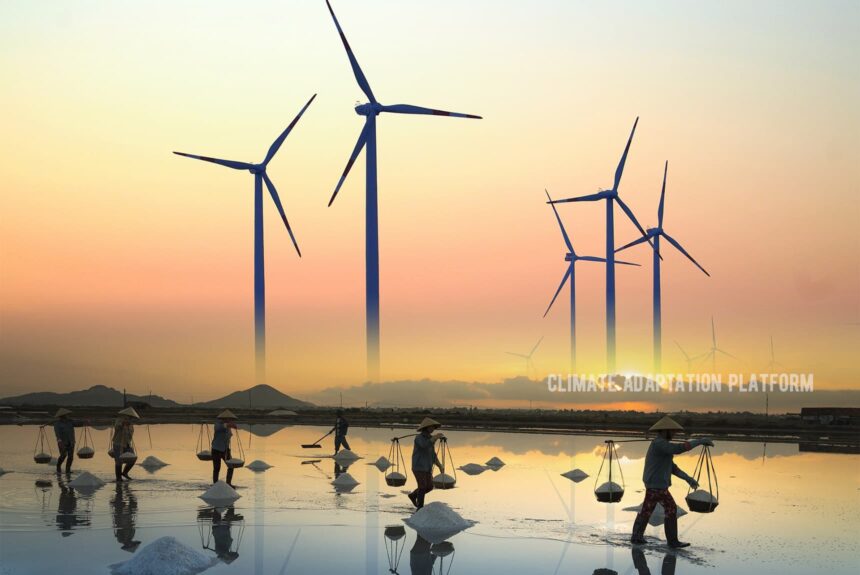Vietnam’s long coastline of 3000 kilometres with winds that blow from 5.5 to 7.3 metres per second, and in other areas off the southern coast of Vietnam that exceed 10 meters per second, gives the country an enormous potential for wind energy.
The speed of about eight meters per second is considered feasible for developing offshore wind power, an advantage Vietnam possesses.
The country has a population of approximately 100 million and is experiencing rapid economic growth. Like other emerging economies in Asia, its power generation is not keeping up with its development which can lead to chronic power outages and could hamper growth.
Offshore wind can support Vietnam’s development, supply and stabilize its power requirements, create jobs in clean energy, help the county meet its net-zero goals, and attract foreign investments.
Saigon News reports that at the 2021 COP26 in Glasgow, Prime Minister Pham Minh Chinh announced that the country plans to achieve net zero emissions by 2050, which means that the country needs to replace coal, which accounts for 50% of all power generation in the country with renewable energy in the medium to long term.
The article says that wind power accounts for around 5% of the country’s power generation, but the government plans to increase this to about 30% by 2050. Onshore plants operated by local companies currently dominate wind power in Vietnam, but it would need technological and financial support from foreign investors to harness its offshore wind generation capacity.
After Vietnam announced its net-zero pledges in COP26, the country has made significant progress in renewable energy uptake, particularly in wind energy, Vietnam Briefing reports. In 2021, the government released a draft of the eighth national power development plan (PDP 8) for 2021, with a vision to 2045.
The PDP8 targets renewable energy to become the country’s primary energy source. It aims to increase the wind energy capacity of about 600 megawatts in 2020 to over 11-12 gigawatts in 2025 and over 18 -19 gigawatts in 2030. “The ratio of wind power capacity will account for 12% of the total installed capacity in 2025 and 13% of the total installed capacity in 2030”, the plan says.
Besides wind power, the country plans to increase solar power, battery energy storage, and pumped-storage hydropower.
On 21 December 2022, the Asian Development Bank (ADB) announced that it signed a $107 million financing project with BIM Wind Power Joint Stock Company (BIM Wind) to support the operation of an 88-megawatt wind farm in Ninh Thuan province in Vietnam. The power plant will offset around 215,000 tons of CO2 emissions annually and help the country reach its net-zero pledges.
According to Saigon News, the Vietnamese government “has high hopes for the active participation of foreign companies”. The article notes that major foreign investors are also eyeing or have started offshore wind projects, which include two Japanese corporations – Sumitomo Corp, Renova, and Denmark’s Orsted, the world’s largest offshore wind power company.
To learn more about Vietnam’s renewable energy adoption, click the source’s links below:
Vietnam offshore wind power sparks influx of foreign investment: Nikkei Asia. (2023, 15 January). Saigon News. Retrieved from https://www.sggpnews.org.vn/vietnam-offshore-wind-power-sparks-influx-of-foreign-investment-nikkei-asia-post99772.html
ADB, BIM Wind Sign $107 Million Financing Package to Support Wind Energy in Viet Nam. (2022, December 21). ADB. Retrieved from https://www.adb.org/news/adb-bim-wind-sign-107-million-financing-package-support-wind-energy-viet-nam
Nguyen, C. (2022, January 10). How Can Investors Seize Vietnam’s Wind Power Potential. Vietnam Briefing. Retrieved from https://www.vietnam-briefing.com/news/how-can-investors-seize-vietnams-wind-power-potential.html/
Vietnam: Key highlights of new draft of national power development plan (Draft PDP8). (2021, 13 March). Global Compliance News. Retrieved from https://www.globalcompliancenews.com/2021/03/13/vietnam-key-highlights-of-new-draft-of-national-power-development-plan-draft-pdp8-04032021-2/



Leave a Reply